#rené prou
Explore tagged Tumblr posts
Text
Le somptueux redesign art déco du train de l'Orient Express
Nouvel article publié sur https://www.2tout2rien.fr/redesign-art-deco-du-train-de-lorient-express/
Le somptueux redesign art déco du train de l'Orient Express

#art deco#bar#design#hotel#Istanbul#luxe#Maxime d'Angeac#orient express#René Prou#Suzanne Lalique#train#voiture#automobile#voyage
3 notes
·
View notes
Text

Ad for art deco furniture designer René Prou's atelier in the May 1930 French Vogue.
(source: Gallica)
3 notes
·
View notes
Text

Ed eccoci nella suite n. 3309 dell’Orient Express.
Costruita nel 1926, la carrozza letto 3309, la più antica del Venice Simplon-Orient-Express, operò per oltre un decennio come parte del servizio Orient Express, compreso quel fatidico giorno del febbraio 1929, quando fu abbandonato per dieci giorni in un cumulo di neve a sessanta miglia da Istanbul.
Alla fine degli anni ‘70, in seguito all’acquisizione delle carrozze da parte di James B. Sherwood, il vagone letto 3309 insieme ad altre carrozze subì un ampio e delicato restauro e iniziò il servizio nel 1982 come parte del Venice Simplon-Orient-Express, A Belmond Train.
Dopo 100 anni ca. dal suo viaggio inaugurale, oggi questa carrozza ospita tre delle sei lussuose Grand Suite, magnificamente restaurate: Vienna, Praga e Budapest.
l'Orient-Express divenne un campo di espressione dell'Art Déco quando, intorno al 1920, fu chiamato il maestro vetraio René Lalique e il decoratore d'interni René Prou per allestire alcune carrozze con pannelli di vetro e intarsi di legni pregiati.
La grande avventura dell'Orient-Express iniziò il 4 ottobre 1883, quando il treno lasciò la Gare de l'Est di Parigi.
Dagli anni Sessanta in poi la sua decadenza fu sempre più evidente e il 19 maggio 1977 il glorioso "treno dei re", diventato "democratico", effettuò il suo ultimo viaggio, con lo stesso percorso che lo rese famoso, il Parigi-Istanbul.
Il treno leggendario che ha attraversato l'Europa e che ha raggiunto il suo apice negli anni Venti, ormai non esiste più:
ora ci sono compagnie private che offrono viaggi di lusso su lunghe tratte internazionali .
Il servizio ferroviario è attualmente gestito da diverse imprese con il nome di Orient Express, ma l’intera tratta originale, con le sue lussuose carrozze, non è più stata ripristinata.
Nel 1982 l’imprenditore americano James Sherwood ha lanciato un servizio ferroviario di lusso, utilizzando carrozze restaurate originali dell’Orient Express, lungo diverse linee da Londra e Parigi fino a Venezia.
Alcune carrozze originali del mitico treno sono oggi in mostra presso il Museo Ferroviario di Salonicco, in Grecia.
Il piacere della scoperta.
10 notes
·
View notes
Text
La Dolce Vita

Set to fully launch in 2025, the train’s interiors – designed by Maxime d’Angeac – have now been revealed. They take their inspiration from the old historic carriages, with notes of Art Deco prevailing through decoration choices. For Paris-based d’Angeac, the process began with exhaustively examining the previous iterations of the trains, the routes they would take, and the context of the time in which they were operating. “The starting point of this fabulous project is a dream,” he says. “It’s a projection into an era – the 1920s – and into the culture of luxury and its artisans. By slipping into the shoes of its creators, from René Prou to Suzanne Lalique, I tried to reinterpret the history of this legendary train, not only with nostalgia but with a desire to extend its history, to transport us to another place.”








0 notes
Text

US Vogue October 1977 💜💜💜💜💜
Saint Laurent's bloused-on-adrawstring dress… worn by Catherine Deneuve. Photographed by Helmut Newton The most blousing for day, right - over a drawstring at the hipin violet angora jersey, with a giant hood, shirred batwing, sleeves. (N.B.:the ankle-wrapped high-heeled shoe; the mink-trimmed musketeer gloves-new Saint Laurent_touches!)… New Deneuve on-film: March or Die. Location here: one of the old wagon-lit compartments, with panels by René Prou and René Lalique, auctioned by Sotheby's in Monte Carlo…. Hair, Edwina; makeup, Thibault. Both Carita.
Photo Helmut Newton
vogue archive
#us vogue#october 1977#fall/winter#seventies#fashion 70s#yves saint laurent#saint lauren paris#ysl#french designer#french style#catherine deneuve#french icon#french actress#blond girl#helmut newton#christophe carita#rené prou#rené lalique
61 notes
·
View notes
Photo

Advertising poster by René Prou for the 1925 Exposition Internationale des Arts Decoratifs et Industriels Modernes, the 1925 World’s Fair in Paris, which began the Art Deco movement.
#Exposition Internationale des Arts Decoratifs et Industriels Modernes#Art Deco#René Prou#1925 World's Fair#advertising poster#International Exhibition of Modern Decorative and Industrial Arts
5 notes
·
View notes
Photo










René Prou
entre Art Déco et Modernisme Between Art Deco and Modernism
Anne Bony , Gavriella Abekassis
Préfaces de Patrick Frey et Lorraine Frey
Norma Editions, Paris 2018, 255 pages, Text in English and French. ISBN 978-2376660033
euro 84,00
email if you want to buy [email protected]
René Prou (1887-1947), ensemblier et décorateur, est, aux côtés de Ruhlmann, Leleu, Dunand, Subes ou Brandt, une figure centrale du mouvement Art déco. Dès 1919, il participe à la plupart des Salons d’automne et des Salons des artistes décorateurs avant de s’imposer à l’Exposition internationale des arts décoratifs de 1925. Nommé à la tête Pomone, l’atelier d’art du Bon Marché, il donne une direction plus moderne aux réalisations.Consacré par de grandes commandes publiques ou privées, son talent d’ensemblier s’exprime notamment dans la décoration de paquebots, l’aménagement de trains de luxe tels que l’Orient-Express ou des magasins Mitsukoshi à Tokyo. Au palais de la Société des Nations, à Genève, il intervient aux côtés de José Maria Sert avec lequel il collabore également au Waldorf-Astoria, à New York. Son style, défini par le galbe et la courbe des piètements en métal, mêlé à une ornementation joyeuse rajeunit et allège les formes pleines et massives de l’Art déco tout en préservant l’harmonie, le confort et une certaine idée d’un luxe simple.Il réunit dans son atelier de jeunes décorateurs et artistes comme Ivan Da Silva Bruhns, sa fille Geneviève Prou, Étienne-Henri Martin, Adrien Ekman, qui participent aux divers aménagements .Cette première monographie est le fruit d’un important travail de recherche entrepris dans les fonds documentaires et les archives familiales restées inédites.
orders to: [email protected]
ordini a: [email protected]
twitter:@fashionbooksmi
instagram: fashionbooksmilano
designbooksmilano
tumblr: fashionbooksmilano
designbooksmilano
#René Prou#Art Deco#Modernisme#paquebots#trains de luxe#Waldorf Astoria New York#décorateur#Mitsukoshi Tokyo#designbooksmilano
39 notes
·
View notes
Text
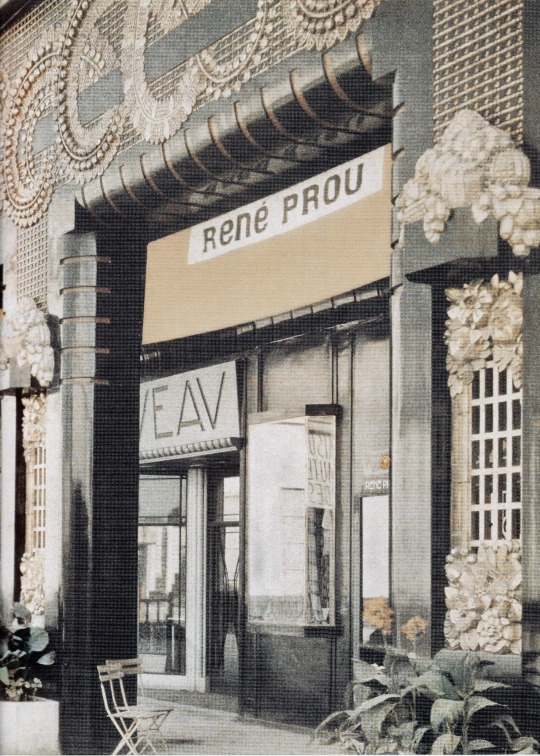
Atelier René Prou
René Prou: Between Art Deco and Modernism
Anne Bony, Gavriella Abekassis
Norma Éditions, 2018
19 notes
·
View notes
Photo

René Prou https://www.instagram.com/p/Cl9eQ7CIYPd/?igshid=NGJjMDIxMWI=
3 notes
·
View notes
Quote
Terra d'adéus T'ho diria rimant decasíl·labs invictes Amidant amorosos alexandrins blancs T'escriuria Roser sense tu no sé viure o A pesar de betzèrries serem sempre amants Tu ja saps que t'estim Sense por ni futur potser ens calgui parlar amb un llenguatge agressiu d'aquest temps malgarbat de falsaris cabrons Com va dir el portuguès que en va escriure un xinxer Són ridícules totes les cartes d'amor i aquí hi sobren polítics de seny pesseter Prou Tristanys i Romeus prou Renés i Abelards El diari du un jove de divuit anys mort i han trobat a La Vall un vaixell amb haixix Jo no jug a ser progre ni em venc al poder Com va dir Saramago Silenci i treball Si m'aferr obsessiu a aquests mots insurgent és perquè tu ja ho saps no sóc jo si no escric i el més íntim exili és un vast sentiment Una empresa vol fer un camp de golf a Tirant no sé d'on trauran l'aigua i mil apartaments Ara acab de llegir Dublinesos de Joyce Prest serem souvenirs mohicans i estrangers
Ponç Pons al Salobre
1 note
·
View note
Text
Five Opulent Wagons‐Lits Get a Final Fare of $302.000.
By Susan Heller Anderson Special to The New York Times.

MONTE CARLO, Monaco, Oct. 9—In the head? and hermetic atmosphere of moneyed elegance that is the chief attraction here, five opulent Wagon‐Lits that for decades rode the rails as part of the Orient Express were auctioned yesterday for $302,000 in what Sotheby Parke Bernet, the auctioneer, believes to be the first: train auction ever held.
A jubilant American, James Sherwood, successfully bid $104,000 for two luxury sleeping cars with rare wood marquetry panels and velvet upholstery. The washrooms of the two cars are fitted with crystal water decanters.
Albert Glatt, the managing director of a Swiss travel company, spent $60,300 for a dining car with gleaming wood panelling, red leather banquettes and ornate brass luggage racks.
André Paccard, a Frenchman, acquired the remaining two carriages for $137,700. One, an elegant Pullman car, had caught the fancy of the German Wehrmacht and was requisitioned during Word! War 11. The other—the most elaborate or the five Art Deco carriages—is a parlor car with wing armchairs designed by Rene. Prou and covered in deep gold embossed velvet. The plane wood panels are encrusted with crystal flowers. René Lalique designed the upholstery panelling.
Mr. Sherwood said that he paid about what he had planned. But Mr. Glatt observed later, in the privacy of an associate's yacht, that he thought the prices were three times what the cars were worth. “It will cost least $20,000 to restore one car;” he said.
The cars belonged to the Compagnie Internationale des Wagons‐Lits and rolled across Europe in the days of deluxe train travel. But such leisure has been replaced by jets and the Wagons‐Lits company, now celebrating its 100th birthday, decided to give up the cars.“They don't have air‐conditioning,” Jacques‐Bernard Dupont, the firm's administrative director, said. “They can't go fast enough—it's not good for them. To build such cars today would cost about $50,000 each.” He said that the company still has about 10 cars from the 1920's but none quite as opulent in decor. Both Mr. Sherwood and Mr. Glatt will put their purchases back on the tracks Mr. Glatt's company presently runs the nostalgic Orient Express, providing deluxe service from Zurich to Istanbul.
The dining car the 10th old carriage his company has bought. Mr. Sherwood, a Kentucky native living in London, is the president of Sea Containers Inc., a New York shipping firm. He hopes to start a venture similar to Mr. Glatt's, going from London to Venice via Dieppe and Paris.“We'll eventually buy 20 cars and cooperate with Mr. Glatt on rolling stock,” Mr. Sherwood said.
Mr. Paccard, the third buyer, would say only that his two cars would remain in France.In a cloud of authentic smoke from the diner's coal burning, stove, the five cars made their last run Friday from Nice to Monte Carlo, leaving 19 minutes late. The trip, which hugs the Mediterranean coastline and normally takes 20 minutes, took 54 minutes, to the astonishment of Margarete Lamboy a tourist from Hanover, West Germany, who had got on by mistake.“I just wanted to get to Monte Carlo,” she said. “And where do I pay?”The remaining 90 passengers were potential buyers, train buffs, the press and 50 friends of Princess Grace. The Princess, wearing a beige poplin Saint Laurent suit, and friends sipped fresh orange juice and nibbled buttery croissants and brioches. Waiters in starched white jackets poured café au lait from silver pots into white Limoges cups with gold monograms.
Each table had a silver bud vase filled with red roses.The train buffs, several of whom have written books this year on luxury train travel, seemed morose over the end of an era.To prolong the nostalgia, Sotheby's later in the day auctioned nearly 200 lots of furniture and objets d'art from the 1900's and 1920's, including 18 lots of marquetry panels and Lalique glass bas‐relief panels from other Wagons‐Lits carriages.
The sale for this part of the auction, approximately $500,000 set several records for Art Nouveau and Déco objects.“Many things went for twice to four times what they brought five years ago,” said Donald Karshan, a Paris collector whose chiffonier by Sue et Mare was in the sale. The piece, which was exhibited in the 1925 Exposition Internationale des Arts Decoratifs that gave its name to the style of the era, fetched more than $9,000, about twice its value in 1972.
Source: The New York Times Archives. Published on Oct. 10, 1977
2 notes
·
View notes
Text
Une bibliothèque de Pierre Cruège

Pierre Cruège (1913-2003), Bibliothèque en chêne ciré, édition Formes, France 1950. élève de René Buthaud et de René Prou, Pierre Cruège est un acteur important de la Reconstruction française (194555).
Parfait état.



Dimensions:
Hauteur: 143,5 cms
Profondeur: 29,5 cms
Largeur: 71 cms
2 notes
·
View notes
Text
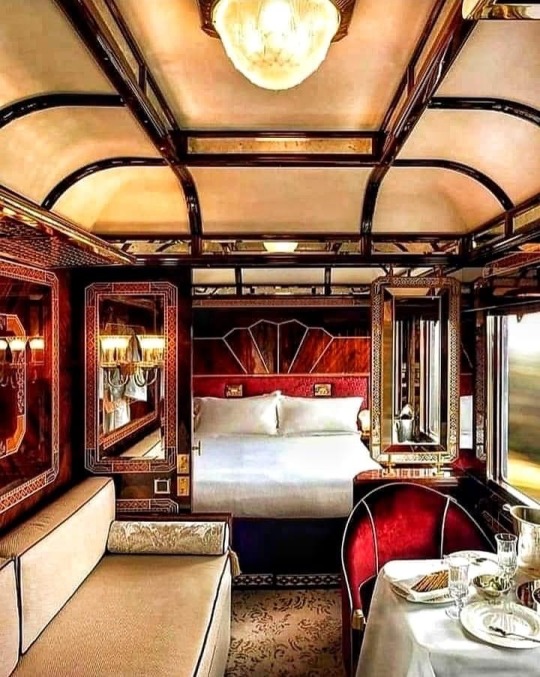
La suite n. 3309 dell’Orient Express.
Costruita nel 1926, la carrozza letto 3309, la più antica del Venice Simplon-Orient-Express, operò per oltre un decennio come parte del servizio Orient Express, compreso quel fatidico giorno del febbraio 1929, quando fu abbandonato per dieci giorni in un cumulo di neve a sessanta miglia da Istanbul.
Alla fine degli anni ‘70, in seguito all’acquisizione delle carrozze da parte di James B. Sherwood, il vagone letto 3309 insieme ad altre carrozze subì un ampio e delicato restauro e iniziò il servizio nel 1982 come parte del Venice Simplon-Orient-Express, A Belmond Train.
Dopo 100 anni ca. dal suo viaggio inaugurale, oggi questa carrozza ospita tre delle sei lussuose Grand Suite, magnificamente restaurate: Vienna, Praga e Budapest.
l'Orient-Express divenne un campo di espressione dell'Art Déco quando, intorno al 1920, fu chiamato il maestro vetraio René Lalique e il decoratore d'interni René Prou per allestire alcune carrozze con pannelli di vetro e intarsi di legni pregiati.
La grande avventura dell'Orient-Express iniziò il 4 ottobre 1883, quando il treno lasciò la Gare de l'Est di Parigi.
Dagli anni Sessanta in poi la sua decadenza fu sempre più evidente e il 19 maggio 1977 il glorioso "treno dei re", diventato "democratico", effettuò il suo ultimo viaggio, con lo stesso percorso che lo rese famoso, il Parigi-Istanbul.
Il treno leggendario che ha attraversato l'Europa e che ha raggiunto il suo apice nei ruggenti anni Venti, ormai non esiste più: ora ci sono compagnie private che offrono viaggi di lusso su lunghe tratte internazionali .
Il servizio ferroviario è attualmente gestito da diverse imprese con il nome di Orient Express, ma l’intera tratta originale, con le sue lussuose carrozze, non è più stata ripristinata.
Nel 1982 l’imprenditore americano James Sherwood ha lanciato un servizio ferroviario di lusso, utilizzando carrozze restaurate originali dell’Orient Express, lungo diverse linee da Londra e Parigi fino a Venezia.
Alcune carrozze originali del mitico treno sono oggi in mostra presso il Museo Ferroviario di Salonicco, in Grecia.
By ArtsLife
9 notes
·
View notes
Photo



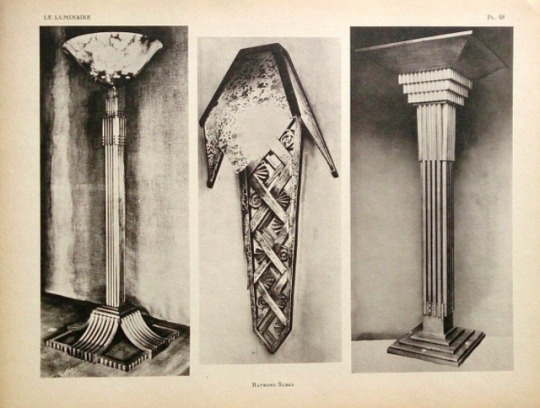



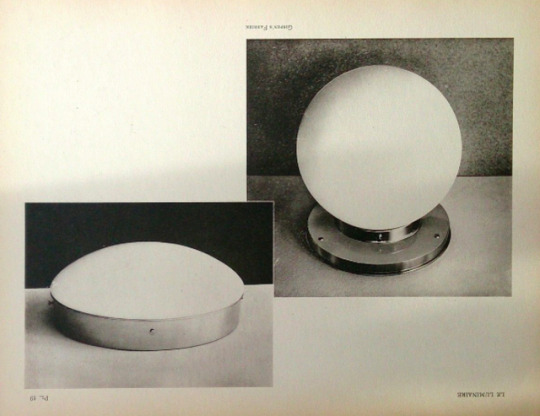

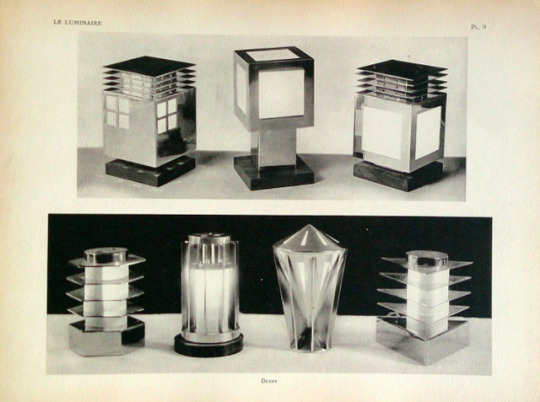
Le Luminaire et Les Moyens D’Éclairage Nouveaux Vol. 2 - Art Deco Lighting, published by Éditions D’Art Charles Moreau, Paris, 1929.
Including lighting designs by Maison Desny, Jacques Adnet, Edgar Brandt, Pierre Chareau, Maurice Dufrene, Genet & Michon, Gispen, Lacroix, Jean Prouvé, Jean Perzel, Wolfgang Tumpel, Sue & Mare, Raymond Subes, René Lalique, René Prou, Paul Zucker and Eduard Schenck among others.
(via eBay)
266 notes
·
View notes
Photo

Gouache sobre papel, Atelier René Prou, circa 1937, Francia. Anécdota: La madre de Patrick Frey, Geneviève, dibujó en el estudio de su padre René Prou, el gran decorador del período de entreguerras, hasta que conoció a Pierre Frey. Los motivos que crea son esencialmente florales e ingenuos. #pierrefrey #lamaisonpierrefrey
Somos #distribuidores #mayoristas de #PapelesPintados #telas #accesorios #revestimientomural y #fabricantes de #estores Más info> http://lemurier.es/
0 notes
